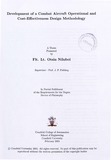JavaScript is disabled for your browser. Some features of this site may not work without it.
| dc.contributor.advisor | Fielding, John | |
| dc.contributor.author | Nilubol, Otsin | |
| dc.date.accessioned | 2009-05-01T11:33:37Z | |
| dc.date.available | 2009-05-01T11:33:37Z | |
| dc.date.issued | 2005-02 | |
| dc.identifier.uri | http://hdl.handle.net/1826/3380 | |
| dc.description.abstract | This study set out to develop an aircraft design methodology, which gives com- bat aircraft more operational and cost-effectiveness by considering these factors early in the design process. In this methodology, an aircraft will be considered as a sub-system of an overall system, representing an entire operation scenario. Measures of operational and operational cost-effectiveness indicate the quality of, and relationships between, the major design aspects; i. e. susceptibility, vulnerability, reliability, maintainability, and operational cost. These measures are functions of aircraft measures of performance and measures of effectiveness. A mission operation simulation was developed as the transfor- mation tool, to performance and effectiveness measures. The measures of aircraft performance developed in this methodology have been evalu- ated by simple, yet sufficient, models because of the paucity of available data, information and the appropriateness of such assessment methods during the early design stages. An aircraft performance in susceptibility terms is measured both in the forms of probability of detection, which is predicted through its radar cross section (RCS), and probability of hit. The RCS prediction model in this study generally uses an aircraft's external shape, and the probability of hit is also evaluated from the aircraft presented areas. The probability of kill is a measure of aircraft performance used the vulnerability design methods. This value relates directly to number and sizes of the critical components installed in the aircraft, and their layout. The modification of the critical component layout can directly affect the aircraft probability of kill. In this study, only two major threat types are considered; i. e. contact and proximity warheads. Manoeuvrability probability has been introduced, and been used together with the sus- ceptibility and vulnerability probabilities to predict the overall operational survivability probability in this study. Aircraft reliability and some maintainability probabilities are predicted by using avail- able unclassified data and fundamental aircraft design parameters and variables by dint of statistical analysis and the Pareto principle. Operational cost in this methodology is calculated throughout the aircraft Life Cycle Cost (LCC) by averaging the total operation cost over the total number of operational aircraft in one base and total number of flying hours for an aircraft fleet's entire life. The average operation cost in conjunction with the number of aircraft lost and of weapons released during the mission simulation gives the total operational cost for the overall scenario. An alternative method used to integrate all probabilities into the operation mission simulation is by using the reliability block diagram technique in conjunction with an event tree diagram. The Monte Carlo simulation technique has been used to generate more accurate results by means of random value usage. Most results from the operation mission simulation are in the form of integer num- bers; therefore, the genetic algorithm optimisation method was mainly used in this study. However, the gradient-based optimisation method can also be used to give approximate predictions. The results from the optimisation can finally be used as examples of how to design a combat aircraft for operational and cost-effectiveness. | en_UK |
| dc.language.iso | en | en_UK |
| dc.publisher | Cranfield University | en_UK |
| dc.rights | © Cranfield University 2005. All rights reserved. No part of this publication may be reproduced without the written permission of the copyright holder | en_UK |
| dc.title | Development of a combat aircraft operational and cost-effectiveness design methodology | en_UK |
| dc.type | Thesis or dissertation | en_UK |
| dc.type.qualificationlevel | Doctoral | en_UK |
| dc.type.qualificationname | PhD | en_UK |
